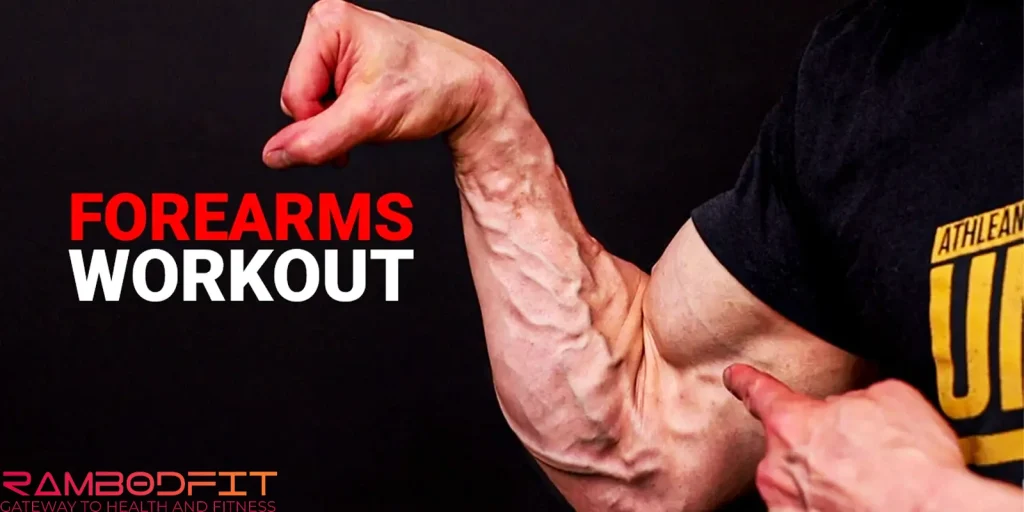


Man, when I first started hitting the weights, I totally bought into that old gym myth—“Dude, your forearms get enough work with pull-ups and deadlifts, you don’t need to train ‘em!” Yeah, right. I’d just grab the bar, crank out my sets, and call it a day. Spoiler alert: my forearms stayed sad and skinny for months. Turns out, just hanging on for dear life during rows doesn’t exactly blow up your forearm size. Who knew? That’s why having a forearm muscle growth guide makes all the difference.
And if you’re one of those lifters always grabbing straps or fancy grips, it’s even worse. Those things? Sure, they help you move more weight, but they basically let your forearms take a nap. Next thing you know, your arms look like you skipped wrist day forever. Trust me, if you want those Popeye forearms instead of limp spaghetti noodles, you gotta hit ‘em directly—no shortcuts, and a forearm muscle growth guide can keep you on track.
Here at Rambodfit, we’re not about that half-baked stuff. We’ll show you the real way to build forearms, science-backed and all, just like you’d train your chest or back. No more excuses, all right? Stick to a forearm muscle growth guide, and you’ll see results faster than you think.
Table of Contents

Look, a ton of gym rats seem to think their forearms just magically grow because they’re clutching barbells all day. Like, “Oh, I deadlift, so my forearms are fine.” Yeah, right. That’s why you see so many chicken-wristed dudes with biceps popping but forearms just… sad. If you actually throw in some direct forearm work, your grip gets stronger, your arms look way more balanced, and honestly, it just looks cooler. A solid forearm muscle growth guide makes sure you don’t skip the details and actually get that complete, powerful look instead of Popeye before the spinach.
Alright, here’s the thing: if you’re chasing bigger forearms, the magic word is volume—yep, same deal as anywhere else you want to grow. So, volume just means, you know, sets times reps times whatever iron you’re chucking around. Simple math, but the payoff’s real. Nobody’s out here running fancy studies on forearm training (why would they, right?), so you gotta piece it together yourself with a solid forearm muscle growth guide to keep things structured.
Honestly, I’ve found that forearms eat up 10 to 20 sets a week and still come back for seconds. I used to tack on, like, four or five sets of forearm curls after my upper body workouts, and did that three times a week. Took a couple months, but—boom—suddenly my grip wasn’t giving out and my sleeves started fitting a little tighter. Not mad about it, and that’s exactly the kind of progress a forearm muscle growth guide helps lock in.
Oh, and here’s a little cheat code: ditch the straps for a while. Just gripping heavy stuff, no shortcuts, forces your forearms to wake up and actually do something. You might hate me for it when the bar feels like it’s trying to escape, but hey, that’s growth—straight out of any smart forearm muscle growth guide.
Alright, so here’s the deal: way too many people think blasting their forearms every damn day is the key to Popeye arms. Can’t really blame ‘em—it sorta makes sense, right? You’re using your grip all the time, so more is better? Nah, not really. Muscles, even the ones you use for holding your phone at weird angles, need a break if you want ‘em to actually grow, and that’s where a forearm muscle growth guide keeps you from overdoing it.
What worked for me? Chopping up my forearm training into a split. Something like:
Splitting it this way kept me from frying my grip and, honestly, my progress finally got moving. Following a forearm muscle growth guide made the whole process structured instead of random guesswork. So yeah, stop torturing your forearms every day. Give ‘em some love, then let ‘em chill.

Look, if your forearms are stuck looking like spaghetti, there’s probably a reason—you’re just grinding out the same boring curls every week. No surprise, your body’s bored too. Muscles need a little chaos to wake up, you know? That’s where a forearm muscle growth guide comes in handy, giving you variety that actually sparks growth. Here’s the stuff that actually gets results:
Wrist Curls
Old-school, yeah, but it works. Grab a barbell, rest it across your thighs, and with your palms up, flex those wrists like you’re trying to show off your nonexistent watch. Feel the burn right in the meat of your forearms—bread and butter for any forearm muscle growth guide.
Wrist Extensions
Now, flip it. Palms down this time, lift your knuckles up. People ignore this move, but honestly, it’s the secret sauce for that balanced, beefy look. Don’t skip it if you want to follow a smart forearm muscle growth guide.
Reverse Curls
Easily my go-to—seriously, if I could only do one, it’d be this. Grab the barbell overhand, curl it up, and watch your forearms and brachioradialis start looking like you actually lift. That thick, rounded pop? This is how you get it.
Quick tip: Don’t get stuck with just barbells. Mix in dumbbells, cables, whatever you’ve got lying around. Your muscles get bored, too—keep them guessing, and with the right forearm muscle growth guide, they’ll grow fast.
Mixing up volume, frequency, and actually choosing exercises that don’t suck—plus not eating like a raccoon—sets you up for gains. But forearms? They’re kinda their own weird animal. Most of those muscles are slow-twitch city, which is exactly why a forearm muscle growth guide focuses on endurance-style rep ranges instead of just heavy singles.
Translation: they get off on high reps. Forget that standard 6–8 reps you might do for curls. Nah, shoot for 15–25 reps each set if you want your forearms to look like you arm-wrestle grizzly bears for fun. Honestly, my forearms never looked remotely impressive until I started cranking out reps nonstop, barely catching my breath between sets. A forearm muscle growth guide makes this high-rep approach way easier to program, and yeah—it’s almost more cardio than lifting, but it works.

Alright, here’s the deal: nobody’s lining up to compliment your forearms at the beach, but honestly? They’re the unsung heroes of your whole upper body game. Forget those chicken wrists—solid forearms tie your arms together and make your grip ironclad, so every other lift feels a bit less pathetic. That’s why following a forearm muscle growth guide pays off way more than just winging it.
You wanna actually build ‘em? Don’t just toss in a few half-hearted wrist curls and call it a day. Hit ‘em with volume, mess around with different exercises, crank up the reps, and don’t flake out after a week. Yeah, it’s slow progress, but stick with it, use a proper forearm muscle growth guide, and your forearms will finally stop looking like afterthoughts.
Further Studies
https://pmc.ncbi.nlm.nih.gov/articles/PMC4540837
Technically, yes—they’ll develop to some extent from pulling movements like rows and deadlifts. But if you want fuller, well-shaped forearms, direct training is essential.
With consistent training, many lifters see visible changes in 8–12 weeks. My own forearms showed noticeable vascularity and size increase within three months once I prioritized them.
Yes, that’s a common approach. Training forearms after biceps ensures you’re already warmed up and minimizes the risk of grip fatigue before heavy pulling exercises.